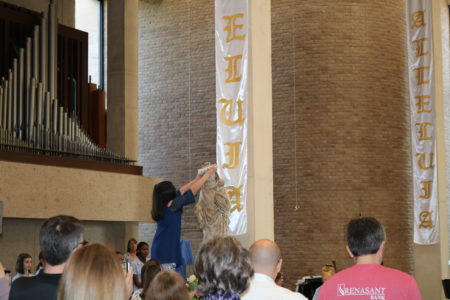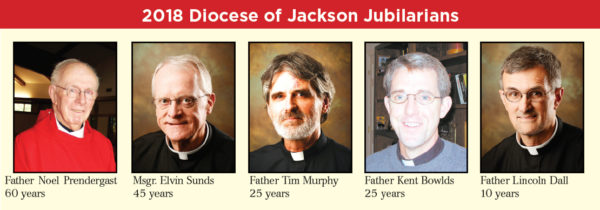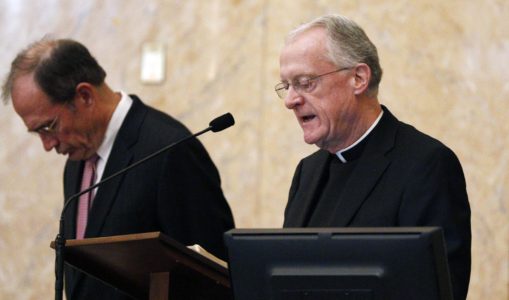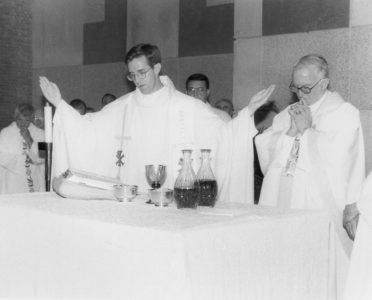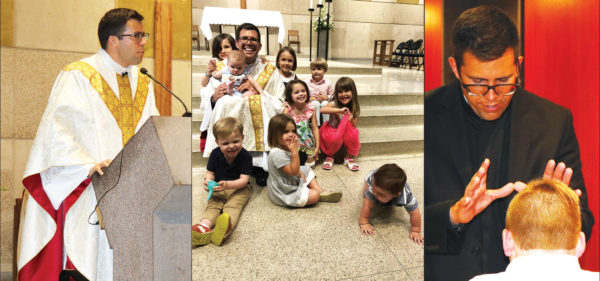
Far Left, Father Nick Adam thanks those who attended his first Mass at Jackson St. Richard. Center, Father Adam with nine of his 12 neices and nephews after Mass. At right, Father Adam blesses Cy Steven, who was an altar server for the first Mass. (Photos by Maureen Smith and Julie Bordes)
Background:
“I am the youngest of eight children, so certainly attending lots of weddings and welcoming many in-laws has been a staple of the Adam family. So has welcoming a lot of nieces and nephews. I am so lucky to have 12 happy nieces and nephews running around,” he said.
His family moved to Elberta, Ala., along the Gulf Coast, when he was 10.
“I was a student at St. Benedict School (4th-8th grade). My mother was my principal during this time. Since we lived so close to the state line the closest Catholic high school was in Pensacola, Florida, so I attended Pensacola Catholic High School. After high school I was sure I wanted to be a sports broadcaster, so I enrolled at the University of Alabama and studied broadcast journalism. I graduated in 2008 and moved to Meridian to work at WTOK – TV.”
While he was in Meridian he began to discern a call to the priesthood. He got support while he discerned from then pastor Father Frank Cosgrove.
Nick’s siblings filled several pews at both his ordination and first Mass, a Mass he celebrated for his mother. “My mother, Claudia, died in 2014 after a long bout with cancer. I remain filled with gratitude for the support that was given to my family by the Church of Jackson during that time. Especially significant was when St. Patrick and St. Joseph in Meridian sent a bus down to Alabama full of parishioners to pray for my mother at the funeral. I learned a ton from my mother, and I believe that this is the culmination of a really awesome plan that God had for me that my mom helped me to see.”
Home parish:
St. Patrick/St. Joseph (Meridian)
Favorite Saints and why?
St. Peter is always a go-to because of his courageous imperfection. He is so willing to put himself out there, and yet we also have so many examples of his own mistakes. I also love St. Paul for his untiring boldness. He gets knocked down again and again and again and just goes back to preach the truth no matter the cost.
Do you have a favorite devotion, religious image or prayer and why?
Having been formed at a seminary called Notre Dame, it is hard to go with any devotion other than one to Our Lady. For the last four years we have ended community prayer with the Marian hymn tota pulchra es (you are all beautiful, Mary). This has become a source of great love and devotion for me.
Who vested you at ordination and why?
Father Frank Cosgrove will vest me at my ordination. He is not only the first person to talk to me about priesthood, but he has also become a very trusted friend and reliable support for me during my discernment and will continue to be a great friend and support as I enter priestly life.
Do you have any hobbies?
I love to play basketball, I am trying to love to golf. I love to talk about sports, to listen to people talk about sports, and to watch sports and then talk about them. I also love any movie that is clever, and can entertain you and make you think about something deeper without resorting to cheap effects or immoral shock value. I love a good book, though it takes me a while to get rolling on them!
In what parishes have you served?
I have served at St. Jude (Pearl), St. Alphonsus (McComb), St. Dominic Hospital (Jackson), and St. Richard (Jackson).
Can you tell me a little about your vocation story?
So yes, about the call and all that! Ok so I had stopped going to Mass while I was in college, and didn’t go to Mass for a while after moving to Mississippi. In 2009 I finally darkened the doorstep of St. Patrick in Meridian. At that Mass I felt an unmistakeable call to something greater, or perhaps more accurately, deeper. I “felt” God calling me, but I didn’t know what he was calling me to. Father Frank Cosgrove helped me immensely during this time to discern the desire that I was experiencing. Eventually it became clear that I needed to check out the seminary, but this took a while to figure out since I had never heard of a seminary before!
My time in seminary has been a gift. I began my formation at St. Joseph Seminary College near Covington, Louisiana where I was educated by the Benedictine monks in philosophy and much much more. Then I moved to Notre Dame Seminary in New Orleans for four years of theological studies. The best thing about the seminary is the fraternity. I was able to learn and live with men who loved God and who wanted to live a life of virtue. Some of those men left formation before being ordained, many are being ordained this summer along with men, and all of us have been made better by the experience.
Along with Father Frank, I am grateful to all the priests who serve on the faculties of both seminaries, as well as the lay professors. I learned so much about living a life of holiness just by witnessing their example. I am especially grateful to Father Jim Wehner, Rector of Notre Dame, whose tireless leadership and spiritual fatherhood was an incredible source of life to me during my time in New Orleans.
Can you share something about yourself people may not know?
I was behind the camera of a viral video that gets shared on YouTube every football season. I interviewed a student at the University of Alabama for a story I was working on about the rivalry between Alabama and Tennessee. This guy really didn’t like Tennessee, like, really. He goes on for about two minutes about all the things that are wrong with the UT football team, and all the Alabama fans love to watch it every year. AL.com actually tracked us both down a year ago to do a “where are they now,” and it was funny because I was in my collar! Ha!
What advice do you have for those discerning a vocation?
Spend time in prayer, and spend time in prayer before the Blessed Sacrament, and when the Lord is really working on you, speak to someone you trust about the way God is working in your life.
Is there one part of priesthood in particular you are looking forward to?
Hearing confessions intimidates me, humbles me, but is also something that I looking forward to. The Sacrament of Penance has been such a source of life to me that I am excited about celebrating that sacrament for others.
What are you looking forward to about your first parish assignment?
The first full day. Yes, I am looking forward to my ordination, my first Mass, etc., but I really am excited about the first full day in the office, starting with celebrating Mass, then responding to whatever is happening on that day. I have realized that life is not about one moment, but it is about constantly coming closer to the Lord through each and every choice you make each and every day, and so I am looking forward to the first full day in the office, the first full day of living as a priest in the parish.


